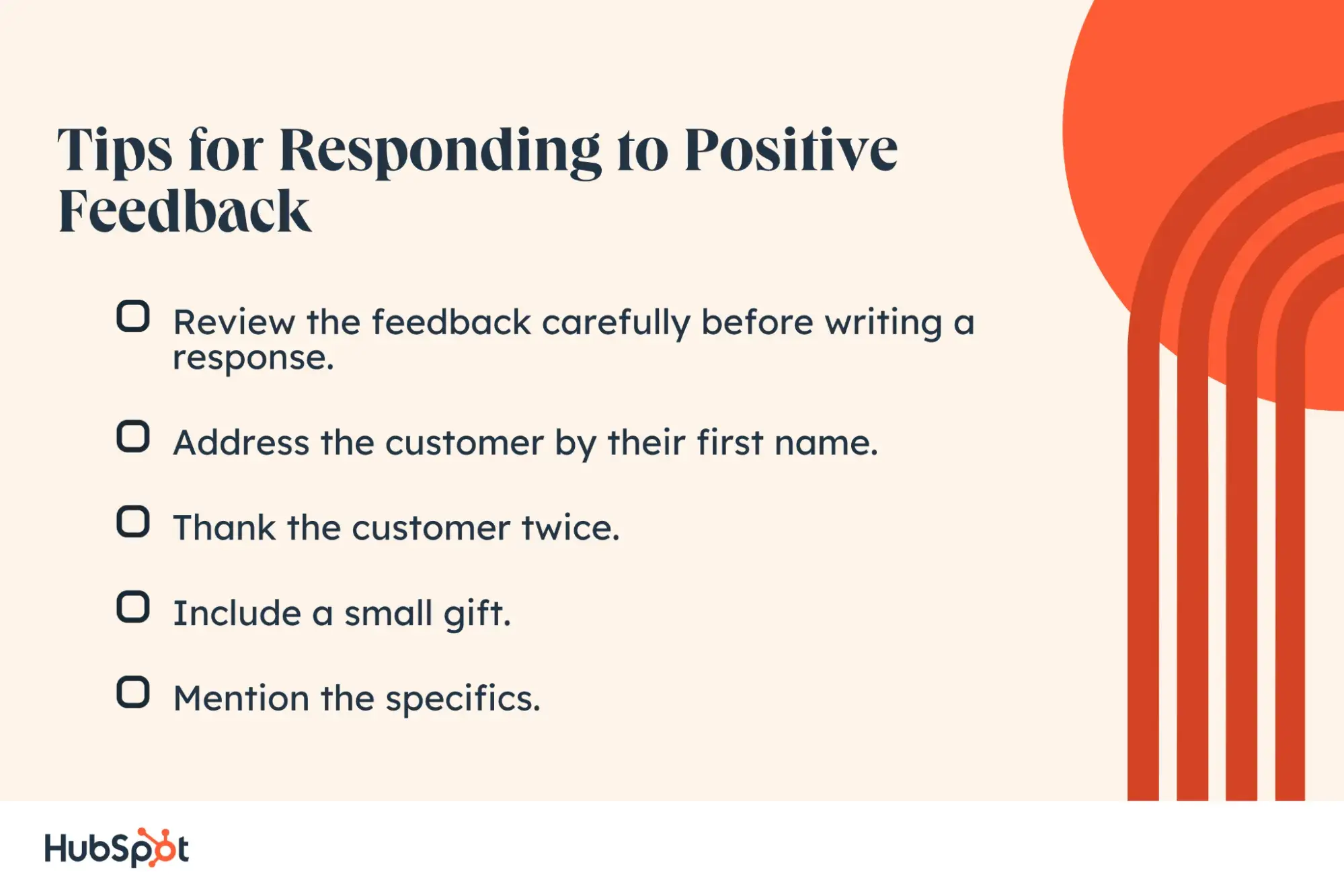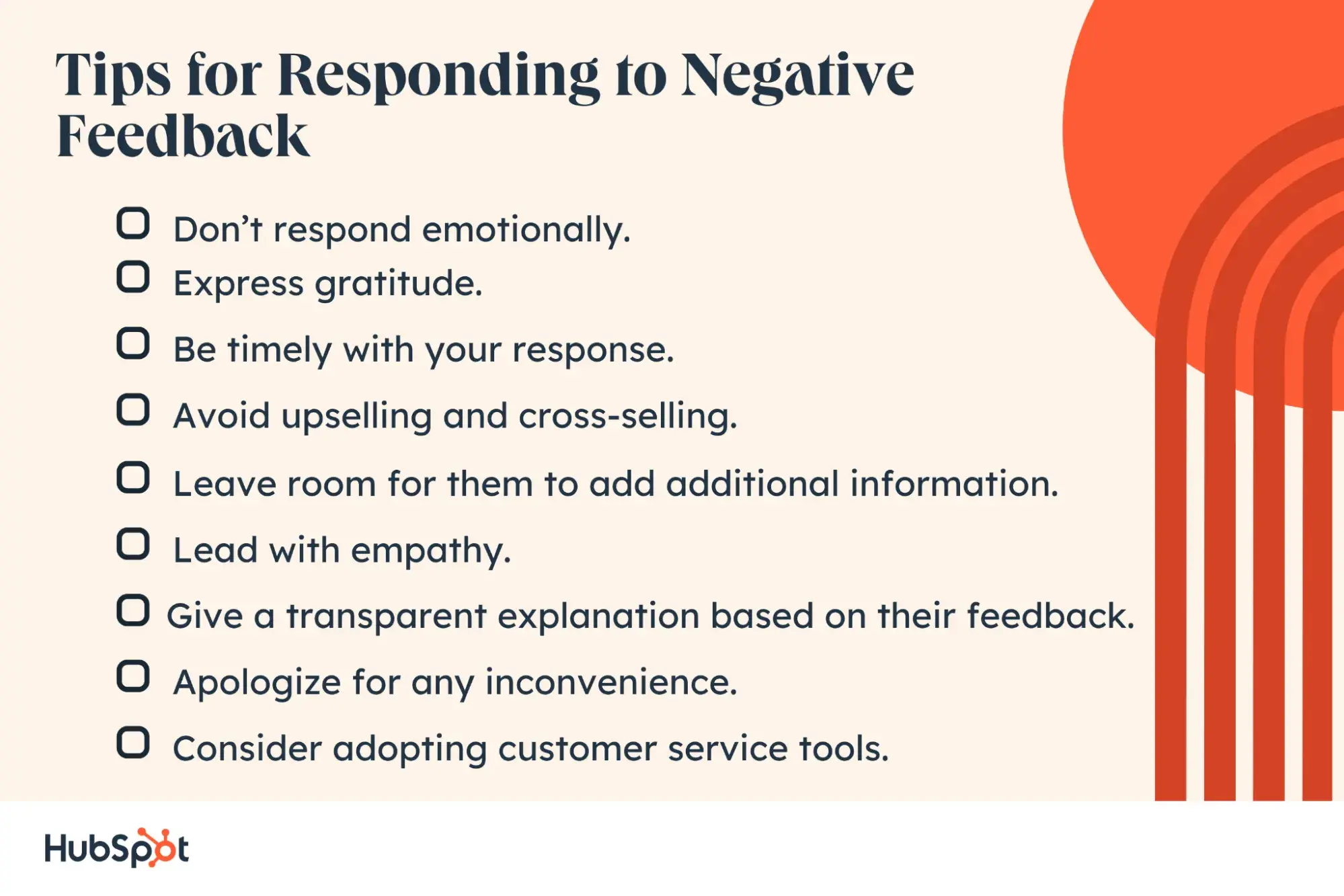Table of Contents
- Tips for Responding to Positive Feedback
- Tips for Responding to Negative Feedback
- Thank You for Your Review Letter Template
- Thank You for Your Feedback Examples
Tips for Responding to Positive Feedback

1. Review the feedback carefully before writing a response.
When you receive positive feedback, it's tempting to respond immediately with enthusiasm:
“Thank you so much!!”
However, I've personally found the key is to take a moment and respond mindfully. You should aim to express gratitude while remaining professional. Don‘t overdo it. Collect your thoughts and craft a reply that illustrates how helpful the customer’s feedback is without seeming overzealous.
Pro tip: Use HubSpot's Customer Thank You Letter Templates to streamline the process.
Download Thank You Templates Now
2. Address the customer by their first name.
I've found that personalization is essential in creating a genuine customer service experience, and sending a “thank you for your feedback” note is no exception. Addressing customers by their first names adds a personal touch and creates a solid, comfortable rapport. This simple detail will make the interaction more genuine and less robotic.
Pro tip: Remember to sign off with your first name as well!
3. Thank the customer twice.
I like to use the “thank you sandwich” approach: start and end your letter with gratitude. Opening with a thank you shows that you value their time and effort to submit feedback. Closing with another reinforces your appreciation. Doubly acknowledging your customers' contributions will make them feel valued and respected.
Pro tip: Don’t go overboard. A sincere thank you is more effective than an overly effusive one.
4. Include a small gift.
If a customer takes the time to leave you positive feedback, show them how much you appreciate it by offering a small gift. A small discount or a free download is enough to make customers feel good about helping you out and incentivize them to do it again.
I recently submitted a review for a guitar pedal I bought from Walrus Audio. In exchange, they rewarded me with a free merch item up to $12. I got to pick from an assortment of things like pins, patches, a tin of picks, stickers, and more. I ended up going with the pin. It’s a little gift, but it elevated my experience as a Walrus Audio customer, so much so that I'm telling you about it now!
Pro tip: Physical gifts serve as lasting reminders of a positive experience with your business and can also be conversation starters.
5. Mention the specifics.
When responding to positive feedback, I like acknowledging specific details from the customer's note. Doing so shows you read their feedback and aren’t sending a canned response. You can mention which teams were involved in their positive experience and explain how their feedback will benefit the customer experience going forward.
Why this works: Acknowledging the specifics of feedback and why it’s helpful makes the customer feel like a valued team member, which is a recipe for customer loyalty.
Tips for Responding to Negative Feedback

1. Don’t respond emotionally.
Negative feedback can be difficult to hear, especially if you feel like it wasn’t deserved. Take your time, and don’t respond impulsively. Trust me, it’s easy to immediately go on the defensive if you’re not careful. Take a step back and let any emotions cool off before crafting a constructive and professional response.
Pro tip: Acknowledging the customer’s frustration is the first step in de-escalating tension.
2. Express gratitude.
I know it sounds strange to thank the customer for negative feedback, but showing gratitude is essential in challenging situations. Even if the feedback is difficult to hear, the customer still took time out of their day to speak about their experience with your company. That is valuable information, and you should acknowledge their effort.
You might consider starting your response with something like this:
“I know you had a difficult experience with [describe experience], but I wanted to thank you for bringing this to our attention.”
3. Be timely with your response.
There’s nothing worse than feeling ignored. Regarding negative feedback, the faster you respond, the better. In my experience, a quick response shows the customer you are paying attention to their input and care about meeting their needs in a timely fashion.
Pro tip: Sometimes, it's appropriate to prioritize responding to negative feedback ahead of other customer inquiries, even if there are other tickets ahead of it in the queue.
4. Avoid upselling and cross-selling.
There’s a time and place for pitching additional products and services, but in the middle of responding to negative feedback is not it. In my experience, customers are understandably sensitive in the aftermath of a negative experience. They might feel undervalued, and the last thing you want is to make them feel like you only care about them for their money.
Pro tip: Focus entirely on addressing their concerns and appreciating their feedback. This will help build trust and show that you value their relationship.
5. Leave room for them to add additional information.
I think inviting customers to share additional details is important, especially when responding to negative feedback. The last thing you want is for the customer to feel like you are brushing them off or rushing to close the case. Instead, keep the door open and make it clear that you are committed to resolving the issue and won’t be closing the case until they are delighted.
Why this works: Seeking clarification and additional information encourages an ongoing relationship and a culture of open communication with the customer.
6. Lead with empathy.
As a support rep, I handled negative feedback from my fair share of frustrated customers. Those experiences taught me that empathy is the key to successful customer interactions.
When responding to negative feedback, I always acknowledge the customer’s concerns and demonstrate that I understand the situation. Then, the most important step, in my opinion, is to show them that you know how the situation made them feel. I’ve noticed that customers are much more open to solutions once they feel understood.
Why this works: Validating the customer's emotions changes the dynamic from confrontation to collaboration. Often, the emotional impact of a problem is more significant than the problem itself.
7. Give a transparent explanation based on their feedback.
If something goes wrong, it’s important to explain what happened. However, this does not mean you should make excuses. In my experience, customers have an uncanny ability to detect insincerity. If the customer’s feedback illuminates a lasting issue or recurring trend, be transparent about it. Explain what’s happening, why, and the steps you are taking to handle it.
Why this works: Meeting customers with transparency helps to build trust and can turn frustrated customers into allies. Being honest with customers makes them feel respected and included in the problem-solving process.
8. Apologize for any inconvenience.
When responding to negative feedback, it’s important to apologize for the customer’s inconvenience. Whether or not you believe the feedback is fair, you should acknowledge the customer’s frustration and offer a genuine apology.
As a support rep, I encountered a few situations where the customer’s frustration was misplaced, but even so, I made it a point to apologize sincerely. I think it’s important to assure customers that whatever negative experience occurred will never happen again, but only if that’s a promise you can make in good faith.
Pro tip: If something goes wrong, consider offering an incentive in return. However, I’ve learned to reserve such gestures for exceptional circumstances to maintain impact and avoid being taken advantage of.
9. Consider adopting customer service tools.
In my experience as a customer support rep, maintaining positive customer relationships requires more than just good intentions. It necessitates organization, consistency, and the right tools. If you are struggling to meet customer needs and receiving negative feedback regarding the consistency and quality of your service, it’s time to adopt a help desk tool if you haven’t already.
Pro tip: While customer service tools are powerful, they are not set-it-and-forget-it solutions. The right tools will help you keep track of feedback and deliver consistent responses, but they are not a substitute for an empathetic and customer-centric attitude.
Thank You for Your Review Letter Template
Dear [Customer Name],
Thanks for sharing your feedback on your experience with our customer support team. We sincerely appreciate your insight, which helps us improve our customer experience.
If you have any more questions, comments, concerns, or compliments, please feel welcome to reach out; we would be happy to assist.
Best,
[Your Name]

Thank You for Your Feedback Examples
Responses to Positive Feedback
- “Thank you for sharing your thoughts with us! We're thrilled to hear about your positive experience with [specific aspect] and are grateful for your continued business.”
- “Your feedback is a treasured gift. It reaffirms our commitment to providing only the highest quality service. Thank you.”
- “This made our day! Thank you for letting us know how much you enjoyed your experience with [specific aspect]. We're here because of customers like you.”
- “We are so glad to hear about your experience. Knowing that we are making your day even a little bit better is everything to us. Thanks for your feedback, and don’t hesitate to reach out again with further insights.”
- “It’s so encouraging to know we are exceeding your expectations. Thank you for taking the time to deliver this feedback. It is truly invaluable to everything we do. As a thank you, I’ve attached a 10% discount code for next time.”
- "It’s always good to hear from you, [Customer Name]. Your continued feedback is a prized asset. It keeps us motivated and disciplined towards only the highest standards.”
- “Your feedback is gold. We’re so pleased we exceeded your expectations with [specific aspect]. We plan to keep it that way. Thank you for your kind words.”
- “We are so grateful you took the time to share your positive experience. Stories like this are what make everything we do worth the effort. Please reach out whenever with future insights. Your feedback drives us forward.”
- “Thanks for the thumbs-up, [Customer Name]. We truly appreciate it. Your support means everything to us, and we look forward to serving you again soon.”
- Thank you for your thoughtful remarks, [Customer Name]. We are honored to receive such praise, and we look forward to satisfying you again in the future. Your feedback helps us do that.”
- “We are happy to know that [specific aspect] was up to your standards. We strive to continue bringing you the highest quality service, and your feedback makes that possible.”
- “Thank you, [Customer Name]. Your words mean a lot. We’ll keep up the good work.”
- “Thank you for your gracious comments. It’s feedback like yours that drives our team towards innovation and maintaining excellence in service. We’re excited to hear your thoughts about [upcoming product release].”
- “Thank you so much for your feedback. Your time is valuable, and we are honored you gave us some of it to share about your experience. Not only is it encouraging to hear such kind words, but it is invaluable information for fueling our continued growth.”
- “Thank you, [Customer Name], for your feedback. It guides us like the stars guide a ship at sea, with unwavering light and direction. We are committed to using your insights as a compass, steering our services towards ever-greater achievements in honor of your support.”
Responses to Negative Feedback
- “We’re very sorry to hear that we missed the mark. I know how frustrating something like this can be, and we aren’t taking it lightly. Thank you for this opportunity to improve our services. We are taking steps to prevent issues like this from happening again.”
- “We're sorry to hear your experience didn't meet expectations. Your feedback is invaluable, and we are committed to making the necessary changes to address this matter. Thank you for sharing your experience and giving us the opportunity to improve and better serve you.”
- “We are saddened to hear that your recent experience wasn’t up to the standard we’ve worked so hard for you to expect. Next time, nothing like this will happen, and we will remain focused on making things right for you.”
- “Thanks for helping us get better, [Customer Name]. We appreciate your constructive comments and are investigating your concerns. Specifically, your insight on [specific aspect] is valuable for improving our services in the future.”
- “Your satisfaction is our top priority, and we are regretful to fall short of those expectations. We are taking steps to make sure nothing like this ever happens again. Please don’t hesitate to reach out with any questions, and thank you for taking the time to deliver us your valuable feedback.”
- “Thank you for bringing this issue to my attention. I’m sorry for the inconvenience this has caused you, but I assure you we’ve already taken steps to resolve the concern. We look forward to your continued support and cherish the opportunity to do better next time.”
- "We‘re grateful for your feedback. It’s essential for helping us grow as a company and better meet your needs. Falling short of your satisfaction is not something we take lightly, but your feedback is invaluable for improving your and all our customers’ experience. Our sincerest apologies for the inconvenience this has caused you, and we look forward to better serving you in the future.”
- “Your words, though harsh, are a gift for which we are grateful. We apologize for the issue you experienced, and you have our word that it won’t happen again in the future. Thank you for your honest feedback. It helps us do better.”
- “First of all, I’d like to thank you for your patience in this matter. I know this has been a time-consuming issue. I’m pleased to share that our team has addressed the problem, and you won’t have this experience again. I sincerely apologize for the inconvenience, and on behalf of all of us here at [Company Name], thank you for your continued support.”
- “Your feedback is crucial to our continued improvement. We understand the disappointment of unmet expectations and apologize for the inconvenience this has caused you. Thank you for sharing with us so we can rectify the situation going forward.”
- “Thank you for bringing this issue to our attention. We understand your frustration and apologize for the inconvenience. Our team is taking immediate steps to address the issue. Please don’t hesitate to reach out if you have any questions.”
- “We're sorry you had a less than stellar experience. Your feedback is crucial for helping us improve, and we appreciate it. Thank you for taking the time to share with us. We look forward to rectifying the situation going forward.”
- "We’re genuinely sorry to hear about this, [Customer Name]. Your experience does not align with our standards, and we are making the necessary changes to ensure it doesn’t happen again. Thank you for your feedback. We appreciate the opportunity to serve you better in the future.”
Showing Customers Your Appreciation
Thanking customers for their feedback is more than just a courtesy. Throughout my brief career as a customer support rep at HubSpot, I discovered that customers will respond to your genuine displays of gratitude with continued support and loyalty. Positive or negative, customer feedback is the wind in your sails for improving your processes and keeping your ship out of the surf and spray.
What surprised me most about thanking customers for their feedback is how deeply they appreciate feeling seen and heard. Customer feedback is vital for your business, and it's essential to make that clear to customers with your words and actions.
Every piece of feedback is an opportunity to better serve your customers in the future. So, embrace your feedback, thank your customers, and always lead with empathy.
Editor's note: This post was originally published in August 2018 and has been updated for comprehensiveness.
Customer Feedback
-1.png?width=112&height=112&name=support%20strategy%20cover%20(4)-1.png)


-1.png)



.png)

-1.png)



